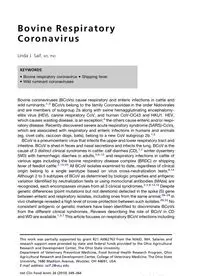
2010 Bovine Respiratory Coronavirus PDF
Preview 2010 Bovine Respiratory Coronavirus
Bovine Respiratory Coronavirus Linda J. Saif, MS, PhD Bovine coronaviruses (BCoVs) cause respiratory and enteric infections in cattle and wild ruminants.1–3 BCoVs belong to the family Coronaviridae in the order Nidovirales and are members of subgroup 2a along with swine hemagglutinating encephalomy- elitis virus (HEV), canine respiratory CoV, and human CoV-OC43 and HKU1. HEV, which causes wasting disease, is an exception;4 the others cause enteric and/or respi- ratory disease. Recently discovered severe acute respiratory syndrome (SARS)-CoVs, which are associated with respiratory and enteric infections in humans and animals (eg, civet cats, raccoon dogs, bats), belong to a new CoV subgroup 2b.1,5 BCoV is a pneumoenteric virus that infects the upper and lower respiratory tract and intestine. BCoV is shed in feces and nasal secretions and infects the lung. BCoV is the cause of 3 distinct clinical syndromes in cattle: calf diarrhea (CD),1,2 winter dysentery (WD) with hemorrhagic diarrhea in adults,3,6–12 and respiratory infections in cattle of various ages including the bovine respiratory disease complex (BRDC) or shipping fever of feedlot cattle.2,13–25 All BCoV isolates examined to date, regardless of clinical origin belong to a single serotype based on virus cross-neutralization tests.8,14 Although 2 to 3 subtypes of BCoV as determined by biologic properties and antigenic variation identified by neutralization tests or using monoclonal antibodies (MAbs) are recognized, each encompasses viruses from all 3 clinical syndromes.2,3,8,14,15 Despite genetic differences (point mutations but not deletions) detected in the spike (S) gene between enteric and respiratory isolates, including ones from the same animal,26–28 in vivo challenge revealed a high level of cross-protection between such isolates.29,30 No consistent antigenic or genetic markers have been identified to discriminate BCoVs from the different clinical syndromes. Reviews describing the role of BCoV in CD and WD are available.1,3,7 This article focuses on respiratory BCoV infections including This work was partially supported by grant R21 AI062763 from the NIAID, NIH. Salaries and research support were provided by state and federal funds provided to the Ohio Agricultural Research and Development Center, The Ohio State University. Department of Veterinary Preventive Medicine, Food Animal Health Research Program, Ohio Agricultural Research and Development Center, College of Veterinary Medicine, The Ohio State University, 1680 Madison Avenue, Wooster, OH 44691, USA E-mail address:
